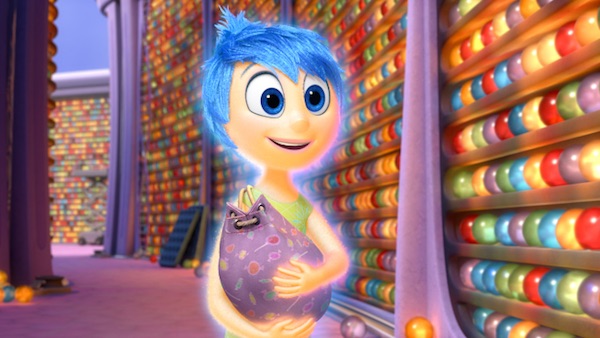Inside Out Review
According to director Pete Docter’s Inside Out, the human mind is a colorful place. It’s also complicated, conflicted, and perpetually changing. In that respect, the film is about as true to life in its intent (if not its execution) as any Pixar movie in recent memory.
(Color-wise, of course, it’s pure fantasy. All the pictures of brains I’ve seen make me believe it’s a mostly monochromatic organ, but I digress…)
Anyway, Inside Out is the beloved animation studio’s best film since Toy Story 3. As many have noted, that’s a statement damning with faint praise. I quite enjoy Monsters University, and Brave has its fans, but most writers and movie fans find common ground when looking at the recent slate of Pixar titles. They’ve been in a relative slump.
Inside Out doesn’t totally end that, but don’t dare call the slump a creative dry spell any more. Docter’s is one of the studio’s boldest, most clever, and most imaginative films ever. And the emotional component you long for in a Pixar property is there in spades. Just because it isn’t perfect—the repetitiveness of the film’s middle third really slows the momentum built by a startlingly enjoyable first third—and just because the studio set such a high bar in the past don’t mean we shouldn’t recognize a work of near genius when we see one.
The film centers around personified feelings inside a young girl’s head. Riley (voice of Kaitlyn Dias) is a happy, goofy 11-year-old with a loving family and a great home in Minnesota. She loves hockey, she’s sociable and honest. Much of that positive growth is owed to Joy (Amy Poehler) the glowing little fairy in her head responsible for keeping Riley on a positive, well-adjusted path. At Joy’s side are Sadness (Phyllis Smith), Fear (Bill Hader), Disgust (Mindy Kaling), and Anger (Lewis Black), all of whom get a crack at guiding Riley on occasion, though they all gladly defer to control freak Joy most of the time.
Riley’s memories are captured in little glass orbs that are colored according to the trait that defines them—yellow for joy, blue for sadness, red for anger, purple for fear, and green for disgust. She also has a handful of “core memories,” which define her “personality islands.” Basically, these extra-special glass balls make Riley who she is.
The fragile, mostly yellow equilibrium that Joy works so hard to maintain is threatened when Riley and her parents move to San Francisco. Upstairs, Sadness seems to exert greater control than she ever has before. Yellow orbs are turning blue, and Joy is freaking out. When the first ever blue core memory rolls in—Riley’s tearful introduction to her new classmates—all hell breaks loose. The core memories, along with both Joy and Sadness, are expelled from the control room and into Riley’s wild subconscious. They need to work their way back with the core memories before the personality islands all shut down, while Fear, Disgust, and Anger need to take the reigns on Riley and keep her negative impulses in check until Joy can fix things.
The film is ultimately about emotional growth, specifically the idea that people can only view the world in black and white terms for so long. As a toddler, it’s good for Riley that Joy dominates her brain space, but as she gets older and starts to face challenges, she needs Sadness to remind her what’s important and make her reach out to her family when in need. Trying to gloss over a problem isn’t solving that problem, and that might sound like a simplistic thing to say, but this film isn’t speaking toward the adult set. Inside Out, I suspect, could be a profound experience for children, and as far as the adults go, they’ll relate because they went through such a change, or they’ll cry their eyes out thinking how their young ones will go through said change soon.
This message manifests itself in the film during some scenes that feel like they’re played mostly for comedy. We get glimpses on occasion of the five traits that live in other characters’ minds—like Riley’s parents. There, all five work as clear equals. They consult with one another. Compared to Riley’s somewhat controlled mental chaos, her mom’s and dad’s minds are well-oiled machines.
Inside Out gets repetitive in its middle third. When the first of five personality islands shuts down, it’s not hard to figure where the film will end up in 30 minutes or so. It doesn’t detract too much from one’s overall enjoyment of the film, but it does keep it out of Pixar’s upper tier of excellence. And not unlike Parks and Recreation, Amy Poehler is an exhausting (if still funny and pleasant) lead. (The same can’t be said for Phyllis Smith, whose Sadness is ironically a joy.)
But I won’t dwell on Inside Out‘s slight faults any further because the end result is such a satisfying emotional experience, not to mention a true feast for your eyes. The creativity and imagination on display are too impressive to ignore.
















